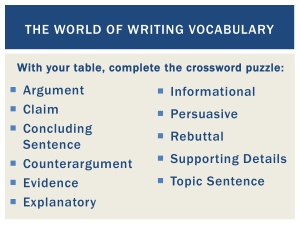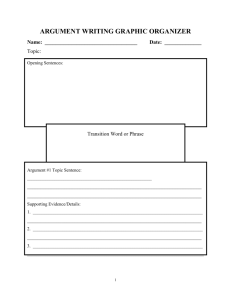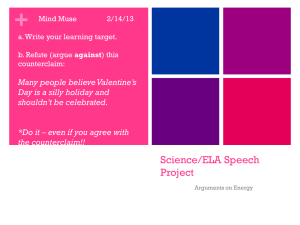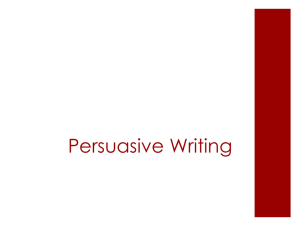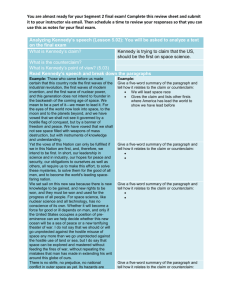Lesson 2 - EngageNY
advertisement
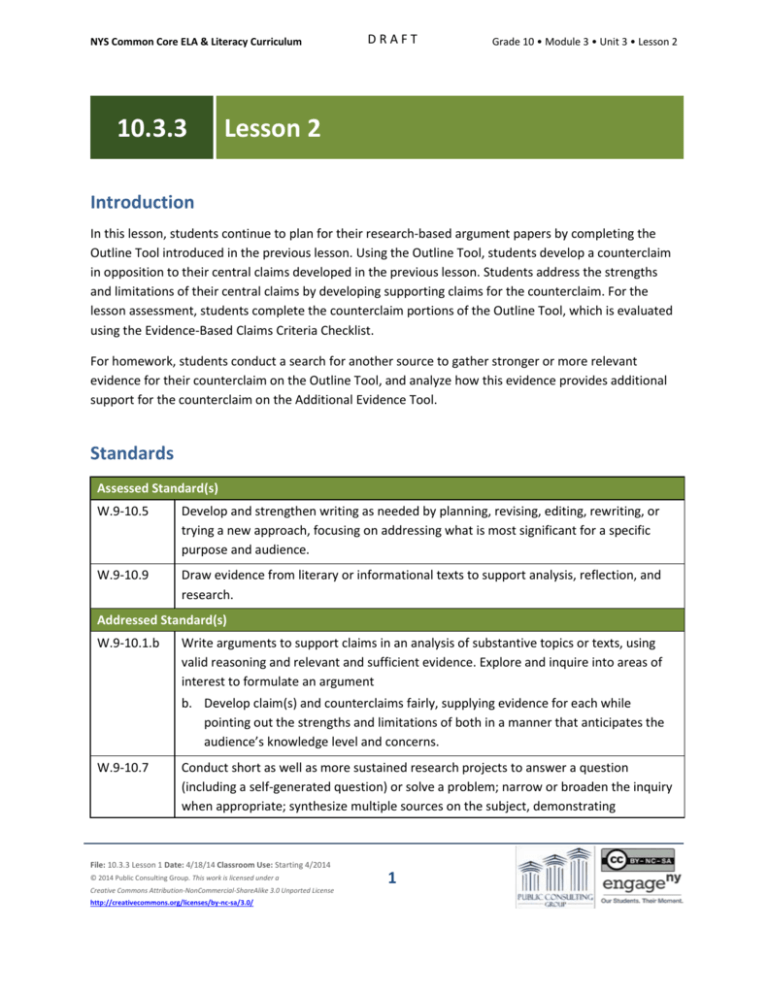
NYS Common Core ELA & Literacy Curriculum 10.3.3 DRAFT Grade 10 • Module 3 • Unit 3 • Lesson 2 Lesson 2 Introduction In this lesson, students continue to plan for their research-based argument papers by completing the Outline Tool introduced in the previous lesson. Using the Outline Tool, students develop a counterclaim in opposition to their central claims developed in the previous lesson. Students address the strengths and limitations of their central claims by developing supporting claims for the counterclaim. For the lesson assessment, students complete the counterclaim portions of the Outline Tool, which is evaluated using the Evidence-Based Claims Criteria Checklist. For homework, students conduct a search for another source to gather stronger or more relevant evidence for their counterclaim on the Outline Tool, and analyze how this evidence provides additional support for the counterclaim on the Additional Evidence Tool. Standards Assessed Standard(s) W.9-10.5 Develop and strengthen writing as needed by planning, revising, editing, rewriting, or trying a new approach, focusing on addressing what is most significant for a specific purpose and audience. W.9-10.9 Draw evidence from literary or informational texts to support analysis, reflection, and research. Addressed Standard(s) W.9-10.1.b Write arguments to support claims in an analysis of substantive topics or texts, using valid reasoning and relevant and sufficient evidence. Explore and inquire into areas of interest to formulate an argument b. Develop claim(s) and counterclaims fairly, supplying evidence for each while pointing out the strengths and limitations of both in a manner that anticipates the audience’s knowledge level and concerns. W.9-10.7 Conduct short as well as more sustained research projects to answer a question (including a self-generated question) or solve a problem; narrow or broaden the inquiry when appropriate; synthesize multiple sources on the subject, demonstrating File: 10.3.3 Lesson 1 Date: 4/18/14 Classroom Use: Starting 4/2014 © 2014 Public Consulting Group. This work is licensed under a Creative Commons Attribution-NonCommercial-ShareAlike 3.0 Unported License http://creativecommons.org/licenses/by-nc-sa/3.0/ 1 NYS Common Core ELA & Literacy Curriculum DRAFT Grade 10 • Module 3 • Unit 3 • Lesson 2 understanding of the subject under investigation. Assessment Assessment(s) Student learning in this lesson is assessed via the counterclaims portion of the Outline Tool. This assessment will be evaluated using the Evidence-Based Claims Criteria Checklist. High Performance Response(s) A High Performance Response should: Include a counterclaim to the central claim as well as supporting claims for the counterclaim (e.g., All tissue should be available for an individual to sell if it does not endanger the individual’s life and would improve his or her financial situation; compensation is necessary to get tissue donations). Provide evidence for the supporting claims (e.g., “With about 114,000 people waiting for organs in the U.S. alone on any given day, and only 3,300 donors, the urgent medical need runs up against moral standards of the value of human life” (Park, par. 6)). Include analysis and limitations of the evidence for the supporting claims (e.g., This evidence demonstrates that there is a high need for donors and a lack of people donating tissue for the purpose of organ transplants. If people were paid for their tissue, they would be much more willing to donate. Though this evidence shows that there are many people who require organ donations it does not say whether enough people have been made aware of this information. There could also be those who are suspicious given the confusing practices of tissue donation). See the Model Outline Tool and the annotated Evidence-Based Claims Criteria Checklist at the end of this lesson. Vocabulary Vocabulary to provide directly (will not include extended instruction) None.* Vocabulary to teach (may include direct word work and/or questions) None.* * Students should use their vocabulary journals to incorporate domain-specific vocabulary from Unit 10.3.2 into their research paper, as well as to record process-oriented vocabulary defined in the lesson. File: 10.3.3 Lesson 1 Date: 4/18/14 Classroom Use: Starting 4/2014 © 2014 Public Consulting Group. This work is licensed under a Creative Commons Attribution-NonCommercial-ShareAlike 3.0 Unported License http://creativecommons.org/licenses/by-nc-sa/3.0/ 2 NYS Common Core ELA & Literacy Curriculum DRAFT Grade 10 • Module 3 • Unit 3 • Lesson 2 Lesson Agenda/Overview Student-Facing Agenda % of Lesson Standards & Text: Standards: W.9-10.5, W.9-10.9, W.9-10.1.b, W.9-10.7 Learning Sequence: 1. 2. 3. 4. 5. 6. Introduction of Lesson Agenda Homework Accountability Developing Counterclaims Strengths and Limitations Outline Tool and Assessment Closing 1. 2. 3. 4. 5. 6. 5% 15% 25% 15% 35% 5% Materials Student copies of the Outline Tool (refer to 10.3.3 Lesson 1) Student copies of the Additional Evidence Tool (refer to 10.3.3 Lesson 1) Student copies of Evidence-Based Claims Criteria Checklist (refer to 10.3.2 Lesson 11) Annotated copies of Evidence-Based Claims Criteria Checklist (teacher use only – see end of lesson) Research Portfolio (refer to 10.3.2 Lesson 1) Learning Sequence How to Use the Learning Sequence Symbol Type of Text & Interpretation of the Symbol 10% no symbol Percentage indicates the percentage of lesson time each activity should take. Plain text indicates teacher action. Bold text indicates questions for the teacher to ask students. Italicized text indicates a vocabulary word. Indicates student action(s). Indicates possible student response(s) to teacher questions. Indicates instructional notes for the teacher. File: 10.3.3 Lesson 1 Date: 4/18/14 Classroom Use: Starting 4/2014 © 2014 Public Consulting Group. This work is licensed under a Creative Commons Attribution-NonCommercial-ShareAlike 3.0 Unported License http://creativecommons.org/licenses/by-nc-sa/3.0/ 3 NYS Common Core ELA & Literacy Curriculum DRAFT Grade 10 • Module 3 • Unit 3 • Lesson 2 Activity 1: Introduction of Lesson Agenda 5% Begin by introducing the agenda and assessed standards for this lesson: W.9-10.5 and W.9-10.9. Explain that in this lesson students are integrating additional evidence into their outline, developing counterclaims, and completing the Outline Tool. Students look at the agenda. Activity 2: Homework Accountability 15% Instruct students to get out their Additional Evidence Tools from the previous lesson’s homework: Conduct a search to find another source to glean stronger or more relevant evidence for a claim on your outline and analyze how this evidence provides additional support for your claim. Record the evidence and analysis on the Additional Evidence Tool. Ask students to form pairs to share what resource and evidence they found and recorded on the Additional Evidence Tool. Students form pairs and discuss the resource and evidence they found and recorded on the Additional Evidence Tool. Student responses will vary based on their individual research and outline. Consider posting the Model Additional Evidence Tool as a reminder of an exemplar response. Return the previous lesson’s assessment, the Outline Tool, to students. Instruct students to revise a claim on their Outline Tool, incorporating the additional evidence they found for homework. Students revise the Outline Tool. Activity 3: Developing Counterclaims 25% Direct students to the counterclaims portion of the Outline Tool. Explain to students that in this lesson, they will develop both counterclaims to their central claims and supporting claims for the counterclaim. Remind students that they developed counterclaims in the previous unit, 10.3.2 Lesson 12. Consider reviewing standard W.9-10.1.b and using the Forming Counterclaims Tool from 10.3.2 Lesson 12 to support student understanding in this lesson. Students follow along. File: 10.3.3 Lesson 1 Date: 4/18/14 Classroom Use: Starting 4/2014 © 2014 Public Consulting Group. This work is licensed under a Creative Commons Attribution-NonCommercial-ShareAlike 3.0 Unported License http://creativecommons.org/licenses/by-nc-sa/3.0/ 4 NYS Common Core ELA & Literacy Curriculum DRAFT Grade 10 • Module 3 • Unit 3 • Lesson 2 Explain to students that in order to present a balanced perspective in the research-based argument paper, it is necessary to develop fairly a counterclaim to an existing central claim. Incorporating a strong counterclaim in the research-based argument paper demonstrates to the audience that the writer has addressed opposing or divergent perspectives. Display the model central claim and counterclaim portions of the Model Outline Tool. Ask students to briefly Turn-and-Talk in pairs to discuss the following question about the relationship between the claim and counterclaim. What is the view of the counterclaim? How is it refuting the central claim? The counterclaim is that people should be able to sell their tissue if it will make their lives better. It is opposed to the idea in the central claim that there should be no profit made by anyone from selling their tissue. Lead a brief whole-class discussion on student responses. Instruct students to form pairs to review their central claims on the Outline Tool and form a counterclaim to their central claim. Remind students to refer to their Research Portfolios if necessary because over the course of their research, they have encountered opposing perspectives concerning their issues. Remind students that if they have several counterclaims to consider, they should think about which counterclaim would provide a more interesting or compelling exploration of the topic. Consider directing students back to the model example to explain that a counterclaim stating that people have a right to profit from their own tissue is compelling because many people have the desire to make more money and there are no ethical issues around people determining the use of their own tissue. Additionally, some people may not profit from their tissue due to lack of informed consent (as in the case of Henrietta Lacks), while others who do know the value of their cells may be able to profit from their use. Students form pairs, review their Research Portfolio, and develop a counterclaim on their Outline Tool. Student responses will vary based on individual research. See the Model Outline Tool for a potential counterclaim. Explain to students that presenting a counterclaim fairly means developing supporting claims and providing evidence as they would when developing a central claim. Students listen. Display the following supporting claims for students. File: 10.3.3 Lesson 1 Date: 4/18/14 Classroom Use: Starting 4/2014 © 2014 Public Consulting Group. This work is licensed under a Creative Commons Attribution-NonCommercial-ShareAlike 3.0 Unported License http://creativecommons.org/licenses/by-nc-sa/3.0/ 5 NYS Common Core ELA & Literacy Curriculum DRAFT Grade 10 • Module 3 • Unit 3 • Lesson 2 Model Counterclaim: All tissue should be available for an individual to sell if it does not endanger the individual’s life and would improve his or her financial situation. Claim: If an individual has a way to profit from their body, they can put themselves in a position to make a lot of money. Claim: Compensation is necessary to get tissue donations. Claim: Researchers should not be the only ones profiting from sale of human tissue. Ask student pairs to discuss the following question: Which of the claims best supports the counterclaim and why? Which supporting claim does not effectively support the counterclaim and why? Consider reminding students that developing a chain of reasoning to support the counterclaim is the same as the exercise in 10.3.3 Lesson 1 in which they developed a chain of reasoning to support their central claim. Student responses should include: o o Compensation is necessary to get tissue donations. Additionally, if an individual has a way to profit from their bodies they can put themselves in a position to make a lot of money, both validate the reasoning of the counterclaim. Both of these supporting claims are logical and sound because they could be supported by evidence. The claim about researchers not being the only ones to profit from tissue is a weaker claim that may not be supported by evidence. Consider instructing students to review their Evidence-Based Claims Criteria Checklist in order to provide more scaffolding to determine if the claim and counterclaim are well developed. Remind students that their claims in support of the counterclaim should use evidence from their Research Portfolios, and demonstrate reasoning. Explain to students that developing supporting claims for the counterclaim is part of the lesson assessment. Students follow along. Activity 4: Strengths and Limitations 15% Explain to students that as they develop their counterclaims they are also assessing the strengths and limitations of the counterclaim in relation to their own central claim. While it is important to use the counterclaim to demonstrate an opposing perspective, ultimately the paper’s central claim is what is argued for and the counterclaim must be refuted. This demonstrates to the audience or reader that the central claim of the paper is the strongest perspective concerning the issue. File: 10.3.3 Lesson 1 Date: 4/18/14 Classroom Use: Starting 4/2014 © 2014 Public Consulting Group. This work is licensed under a Creative Commons Attribution-NonCommercial-ShareAlike 3.0 Unported License http://creativecommons.org/licenses/by-nc-sa/3.0/ 6 NYS Common Core ELA & Literacy Curriculum DRAFT Grade 10 • Module 3 • Unit 3 • Lesson 2 Provide students with the following definition: refuted means “proved to be false or in error.” Students write the definition of refuted in their vocabulary journals. Explain to students that as they develop the supporting claims for the counterclaim, they will be questioning their original central claim. In the “Reasoning” portion of the Outline Tool for the supporting claims of the counterclaim, instruct students to consider how this evidence is limited compared to the evidence they have for their supporting claims for their central claim. Display and discuss a model supporting claim for the counterclaim from the Model Outline Tool: The model supporting claim is “Compensation is necessary to get tissue donations.” The evidence supporting this claim is: “With about 114,000 people waiting for organs in the U.S. alone on any given day, and only 3,300 donors, the urgent medical need runs up against moral standards of the value of human life.” (Park, par. 6). Provide reasoning to connect the evidence to the claim: This evidence demonstrates that there is a high need for donors and a lack of people donating tissue for the purpose of organ transplants. If people were paid for their tissue, they would be much more willing to donate. Explain how the evidence is limited in relation to the central claim: Though this evidence shows that there are a lot of people who require organ donations, it does not say whether enough people have been made aware of this information. There could also be those who are suspicious given the confusing practices of tissue donation. Inform students that pointing out the limitations of the counterclaim’s evidence is like finding flaws or weaknesses in the evidence. It is important to do this thinking on the Outline Tool so students can easily integrate it into the paper in subsequent lessons. Students listen and follow along with the modeling. Consider reminding students of the definition of limitations (“real or imaginary points beyond which a person or thing cannot go”), which was introduced in 10.3.2 Lesson 12. Activity 5: Outline Tool and Assessment 35% Explain to students the Outline Tool is the lesson assessment. They will be assessed on the counterclaim as well as the supporting claims, evidence, and reasoning for the counterclaim. Instruct students to record the supporting claims for the counterclaim on the “Supporting Claim” portion of the Outline Tool, the evidence on the “Evidence” portion of the Outline Tool, and the reasoning on the “Reasoning” portion of the Outline Tool. Remind students that when completing the “Reasoning” portion of the Outline Tool that they should explain how the evidence supports the counterclaim and how the evidence is limited. File: 10.3.3 Lesson 1 Date: 4/18/14 Classroom Use: Starting 4/2014 © 2014 Public Consulting Group. This work is licensed under a Creative Commons Attribution-NonCommercial-ShareAlike 3.0 Unported License http://creativecommons.org/licenses/by-nc-sa/3.0/ 7 NYS Common Core ELA & Literacy Curriculum DRAFT Grade 10 • Module 3 • Unit 3 • Lesson 2 Inform students that the Evidence-Based Claims Criteria Checklist guides the evaluation of this assessment, and that students should refer to their checklists while completing their Outline Tool. Consider reminding students of the research writing skills inherent in W.9-10.7. Students complete the following portions of the Outline Tool: “Counterclaim,” “Supporting Claims (for the counterclaim),” “Evidence” and “Reasoning.” Distribute the Additional Evidence Tool and instruct students to record their counterclaim on the Additional Evidence Tool. Students turn in their Outline Tool after recording their counterclaim on the Additional Evidence Tool. Activity 6: Closing 5% Display and distribute the homework assignment. For homework, instruct students to search for another source to gather stronger or more relevant evidence for a counterclaim on their outline, and analyze how this evidence provides additional support for their counterclaim. Instruct students to record their evidence and analysis on the Additional Evidence Tool. Students follow along. Homework For homework, search for another source to gather stronger or more relevant evidence for a counterclaim on your outline, and analyze how this evidence provides additional support for your counterclaim. Record the evidence and analysis on the Additional Evidence Tool. File: 10.3.3 Lesson 1 Date: 4/18/14 Classroom Use: Starting 4/2014 © 2014 Public Consulting Group. This work is licensed under a Creative Commons Attribution-NonCommercial-ShareAlike 3.0 Unported License http://creativecommons.org/licenses/by-nc-sa/3.0/ 8 DRAFT NYS Common Core ELA & Literacy Curriculum Grade 10 • Module 3 • Unit 3 • Lesson 2 Model Outline Tool Name: Class: Date: [Introduction] Problem-Based Question: Who should own tissue, or profit from tissue after it has been surgically removed from a patient's body? Central Claim: Granting anyone the rights to sell human tissue is morally and ethically questionable; neither researchers nor patients should have rights to sell any human tissue. [Body] Supporting Claim: Patients granting permission to a research institution to use donated tissue can confuse who actually owns the donated tissue. Evidence: Reasoning: How does the evidence support your claim? “As it stands now, tissue banks appear to have de facto ownership over sample inventories and the right to use them as they wish.”(Schmidt, par. 3) This evidence clearly supports the claim because it states that the tissue banks have inherent ownership over donated tissues even though patients might still think they have ownership over their tissue. Supporting Claim: The sale or resale of human tissue is dehumanizing and exacts a psychological toll on the patient or the patient’s family. Evidence: “When Moore found out that he was Patent No. 4,438,032, he felt that his integrity had been violated, his body exploited and his tissue turned into a product.” (Andrews, par. 6) File: 10.3.3 Lesson 1 Date: 4/18/14 Classroom Use: Starting 4/2014 © 2014 Public Consulting Group. This work is licensed under a Creative Commons Attribution-NonCommercial-ShareAlike 3.0 Unported License http://creativecommons.org/licenses/by-nc-sa/3.0/ 9 Reasoning: How does the evidence support your claim? This evidence demonstrates how a patient felt after their tissue had been sold. This evidence clearly shows that there are damaging effects, emotionally and mentally, for patients whose tissues are sold. This is compelling evidence to support the central claim that no one should be allowed to profit from human tissues. NYS Common Core ELA & Literacy Curriculum DRAFT Grade 10 • Module 3 • Unit 3 • Lesson 2 Supporting Claim: The legal issues that deal with patients’ rights to tissue removed during surgery need to be clearly defined because doctors and researchers can profit from tissue taken during surgery. Evidence: “tissue banking is big business and the law is readily side-stepped by invoking ‘processing and handling fees’ so that the tissue itself is not officially sold.” (Josefson, par. 7) Reasoning: How does the evidence support your claim? This evidence shows the questionable activity involved in the tissue banking system. This is one way for doctors to profit and biotechnology companies to get access to human tissue samples. This is the sort of behavior that takes place when tissues can be sold for profit. Supporting Claim: Giving researchers legal ownership of others’ genes, cells, or tissues infringes on individuals' rights to privacy and control over their unique genetic information. Evidence: “In a study of potential tissue donors, 32 percent said they would be offended by the patenting of products of research with their DNA.” (Andrews, par. 11) Reasoning: How does the evidence support your claim? This evidence supports the claim because it clearly states that there are large portions of people who do not want their unique DNA being used by companies. Since everyone’s DNA is unique this would violate their privacy because it would be clear where the genetic material came from and may disclose information about themselves or their family. Counterclaim (to the central claim): All tissue should be available for an individual to sell if it does not endanger the individual’s life and would improve his or her financial situation. Supporting Claim (for the counterclaim): Compensation is necessary to get tissue donations. File: 10.3.3 Lesson 1 Date: 4/18/14 Classroom Use: Starting 4/2014 © 2014 Public Consulting Group. This work is licensed under a Creative Commons Attribution-NonCommercial-ShareAlike 3.0 Unported License http://creativecommons.org/licenses/by-nc-sa/3.0/ 10 NYS Common Core ELA & Literacy Curriculum DRAFT Evidence: “With about 114,000 people waiting for organs in the U.S. alone on any given day, and only 3,300 donors, the urgent medical need runs up against moral standards of the value of human life.” (Park, par. 6) Grade 10 • Module 3 • Unit 3 • Lesson 2 Reasoning: How does this evidence support the counterclaim? This evidence demonstrates that there is a high need for donors and a lack of people donating tissue for the purpose of organ transplants. If people were paid for their tissue, they would be much more willing to donate. Though this evidence shows that there are many people who require organ donations it does not say whether enough people have been made aware of this information. There could also be those who are suspicious given the confusing practices of tissue donation. Supporting Claim (for the counterclaim): If an individual has a way to profit from their body, they can put themselves in a position to make a lot of money. Evidence: “Even if patients lack such property rights, there are many examples of individuals receiving financial compensation for donating tissue. A striking case was that of Ted Slavin, a man with hemophilia who developed extremely high antibody titers after contracting hepatitis B (4). When his physician informed him that his blood might be valuable to medical researchers, he was able to sell his serum for as much as $10,000 per liter, providing himself with a source of income for the rest of his life.” (Truog, Kesselheim, and Joffe, p. 37) File: 10.3.3 Lesson 1 Date: 4/18/14 Classroom Use: Starting 4/2014 © 2014 Public Consulting Group. This work is licensed under a Creative Commons Attribution-NonCommercial-ShareAlike 3.0 Unported License http://creativecommons.org/licenses/by-nc-sa/3.0/ 11 Reasoning: How does this evidence support the counterclaim? This is an example of someone who was able to support himself for his entire life because of his blood. If he was not allowed to sell his tissue he never would have been able to make so much money and this evidence shows that there is a lot of money to be made from selling human tissue. This example makes a good point about there being a potential for individuals to make a lot of money from their body. But this is not available to everyone and it is also likely that cases are very rare where people could make as much as Slavin from their tissue. There is the added problem of informed consent: what is to be done in such cases as Henrietta Lacks whose family did not have the benefit of the knowledge of the cells or their value? In order to profit as Slavin did it seems that it is even rarer to be NYS Common Core ELA & Literacy Curriculum DRAFT Grade 10 • Module 3 • Unit 3 • Lesson 2 able to not only have tissue of this value but also to know its value and use it to make a profit. [Conclusion] Restate Central Claim: In order to protect the rights of patients and the privacy and dignity of individual human beings, neither researchers nor patients should have rights to sell tissue. From Outline Tool, by Odell Education, www.odelleducation.com. Copyright (2013) by Odell Education. Adapted with permission under an Attribution-NonCommercial 3.0 Unported license: http://creativecommons.org/licenses/by-nc/3.0/. File: 10.3.3 Lesson 1 Date: 4/18/14 Classroom Use: Starting 4/2014 © 2014 Public Consulting Group. This work is licensed under a Creative Commons Attribution-NonCommercial-ShareAlike 3.0 Unported License http://creativecommons.org/licenses/by-nc-sa/3.0/ 12 DRAFT NYS Common Core ELA & Literacy Curriculum Grade 10 • Module 3 • Unit 3 • Lesson 2 Model Additional Evidence Tool Name: Class: Date: Counterclaim: All tissue should be available for an individual to sell if it does not endanger the individual’s life and would improve his or her financial situation. Source: “A Court Allows Payment for Bone Marrow. Should People Be Able to Sell Their Parts?” Alice Park, http://healthland.time.com/2012/07/02/a-court-allows-payment-for-bone-marrow-shouldpeople-be-able-to-sell-their-parts/. Evidence: Reasoning: How does the evidence provide additional support for your counterclaim? What are the limitations “Still, the benefits of compensating people for of the evidence? providing cells like bone marrow—which the body replaces and which involves a relatively This evidence provides additional support for the safe extraction—may be wide-reaching, as counterclaim because it references procedures that are Flynn and the plaintiffs argue. ‘In some sense, already taking place that are safe and compensate this is a policy experiment, and it could individuals for their tissue. If a professor of bioethics potentially be groundbreaking," says Jeffrey thinks that it is a good idea to pay for donations, then Kahn, professor of bioethics and public policy this is a strong piece of evidence to use to support the at the Johns Hopkins Berman Institute of perspective of the counterclaim. This kind of Bioethics.’ If we compensate donors who give transaction would benefit those who need donations by apheresis and more people end up and those who are giving the donations. receiving [blood-] stem-cell transplants, maybe we should think about this for other kinds of donations." (par. 8) Not all tissues are like bone marrow. There could be potentially dangerous procedures practiced if compensation is the main reason individuals are donating tissue. File: 10.3.3 Lesson 1 Date: 4/18/14 Classroom Use: Starting 4/2014 © 2014 Public Consulting Group. This work is licensed under a Creative Commons Attribution-NonCommercial-ShareAlike 3.0 Unported License http://creativecommons.org/licenses/by-nc-sa/3.0/ 13
